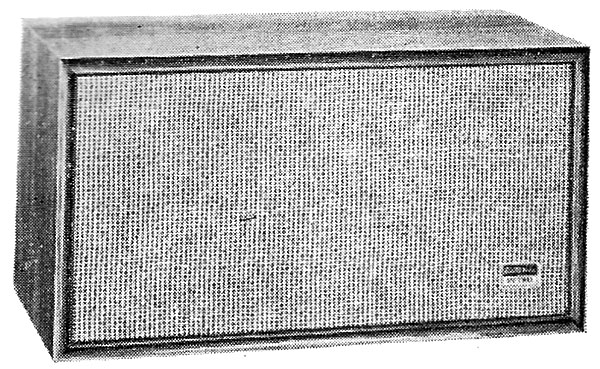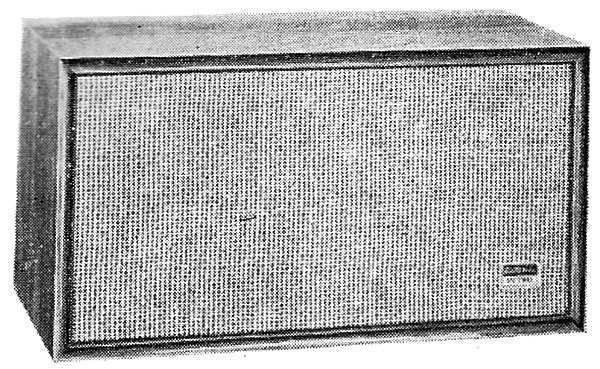| Columns Retired Columns & Blogs |
Hi
Having missed a lot as being somewhat new here, how "subjective response" was carried with such accuracy so close to manufacturer's published response ??
Jack L

The Model 6 is a rather large four-way system employing an 18" woofer with a ½"-thick cone of light, rigid foam plastic (See "Farewell to the Paper Cone," in Vol.1 No.1 of The Stereophile), an 8" paper-cone driver for the lower-middle range, and compression-type horn units for the upper ranges. Crossovers are at 250, 800 and 3500Hz (footnote 1). A five-position rotary switch provides treble adjustments in steps of about 2.5dB, hinged at about 1500Hz. Position 3 is the Normal response setting, which we used for our tests.
Oscillator checks on the Model 6 revealed something we had never before encountered: The system's subjective response (fig.1) seemed to agree almost exactly with the manufacturer's published response curve! The same was found to be the case with the Model 2, so we are publishing the manufacturer's own response data with this report as an aid in interpreting our comments about the sound of these systems. Like the other subjective response curves published in recent issues of The Stereophile, these curves have their vertical scales adjusted so that a response deviation that is barely perceptible to the eye will be barely perceptible to a critical ear.

No spurious sounds were evident when sweeping the oscillator through the speaker's middle and upper ranges, but at frequencies below 50Hz, some harmonics were audible even at moderate input power levels. At levels corresponding to fairly high listening volume on program material, harmonic content was readily apparent below 40Hz.
Sound Quality: the Model 6
On music, the E-V 6 sounded big, rich, and markedly boomy. The boominess sounded like the result of underdamping of the woofer, since it seemed to be induced by any deep bass note instead of by a narrow range of frequencies. As a result, the entire bass range was somewhat obscure and deficient in detail, and the very deepest notes (and some of them were very deep) were significantly masked by the higher-pitched boominess.

The system, like all E-V speakers we have heard, was an excellent reproducer of brass instruments, and at low-to-moderate volume levels, it was judged completely free of the raucous brilliance we have heard from early E-V speakers. There was very little coloration, and what there was consisted of a slight "snarl" in the upper middle range and some mild sizzle up around 10kHz which tended to exaggerate record surface noise and added a subtle wiry quality to string tone. The tweeters were quite directional, providing subjectively uniform treble over a range of only about 40 degrees, so stereo center fill-in was not very good until the speakers were placed fairly close together. The accompanying instructions show the optimum speaker spacing.
Sonic details were fairly well reproduced, but transient response was not comparable to that of a good electrostatic system. At higher-than-moderate listening levels (in an 8' × 20' × 13' room), the Model 6 took on an edge of shrillness and added an odd gargling quality to the sound, as though some of the elements associated with the upper range were tending to ring or to go into marginal overload.
For $300, we would have expected more of this system. Admittedly, we have not heard another system in this price range that we would consider as good as the E-V Model 6, but on the other hand, we have heard less costly ones that, to us, are better-sounding. For example, $240 will buy a Janszen four-element electrostatic tweeter and its mating 350 woofer, with a suitable enclosure. And although the Janszen tweeter, too. leaves some thing to be desired for stereo reproduction (because of its multiple treble beams), the overall system performance would, in our opinion, be superior to that of the E-V 6.
The Model 2
The E-V Model 2, at S120, has even stiffer competition than the Model 6, for there are more high-fidelity speaker systems in this price range than in any other, and some of them are very, very good. The Model 2 has a 12" high- compliance woofer in a sealed enclosure, and a horn-loaded compression tweeter for the range above 800Hz. A three-position slide switch controls treble balance above about 1.5kHz, in increments of about 5dB (at 10kHz) above and below normal level.

Oscillator checks on the Model 2 did not reveal any marked response irregularities throughout the audio range (fig.2), and no distortion products were audible above 50Hz. Below this frequency, the woofer in the Model 2 seemed actually to have less distortion than that in the Model 6, at equivalent output levels. Only at quite high levels was some distortion evident from the woofer, and this was audible as a slight fluttering modulation rather than as perceptible harmonic tones.

Sound Quality: the Model 2
The Model 2's overall sound was similar to that of the Model 6, with somewhat less high-end detail and less low-bass output. The differences were not, however, as pronounced as the differences in their response curves would suggest, and frankly, we rather preferred the Model 2's softer high end, as it did not emphasize surface noise and it lacked the slight wiry quality that the Model 6 imparted to string tone. Like the Model 6, the E-V 2 was quite boomy, and this may have helped to account for the relatively small difference we observed between the low-bass output of the two systems.
The Model 2 has a quality of "aliveness" and presence (and we don't mean that in its derogatory sense) that is somewhat lacking in direct-radiator systems, and many listeners may prefer it. We would still choose the Janszen Z-500 as the best unit in this price class, if only because our long-time exposure to good electrostatic sound has spoiled us for any thing with less over-all transparency and detail.

Hi
Having missed a lot as being somewhat new here, how "subjective response" was carried with such accuracy so close to manufacturer's published response ??
Jack L

Having missed a lot as being somewhat new here, how "subjective response" was carried with such accuracy so close to manufacturer's published response??
I wish Gordon Holt was still around to answer your question - he passed away in 2009 - but you could check out his 1966 article on subjective loudspeaker testing at www.stereophile.com/content/subjective-loudspeaker-testing.
John Atkinson
Technical Editor, Stereophile

...... the whole story." quoted J. Gordon Holt 1966
As of 2020 today, I beg to disagree Gord's above statement dated 1996.
Spec is to tell us consumers how an audio equipment is design/built to whatever standard. It bears very very minute, if any at all, reference to how our ears/brain will percieve.
Again to support my comment above, I quote Cheever's audio engineering Master's thesis: a tube power amp measured 5-10% THD sounded much better than a solid state power amp with more output power, measured 0.002%.
This sonic result was later verified by another party with ABX double blind test.
Listening is believing
Jack L

...... that the system in question sounds smoother and cleaner than any other we've heard to date, it reproduces without apparent attenuation (and very cleanly) bass notes that, according to the musical scores,.." quoted J. Gordon Holt 1966
What amazed me is Gord & his team could draw up a frequency response curve by LISTENING only, so close to the manufacturer's published response. How could they do so so accurately ???
Hopefully, they did it without first reading the published curves !!
Jack L

....... more musical sound from most loudspeakers than any others" quoted J Gordon Holt.
I still keep my ST-70 power amp. fully upgraded, on back burner. Yes, St-70 was an icon of quality sound back then. But after half a century today, we find St-70 needed upgrading to cope with the advanced audio technology todate.
Now my ST-70, after my upgrade, reproduces "elicit CLEANER, more MUSICAL sound" to my critical ears of 2020 sonic standard.
Listening is believing
Jack L

I'd ask him what he means when he says : we.
"We" heard this, "we" discovered, "we" felt, "we" should've, etc....
I kinda thought that he had a group that he was speaking for, hence the ever present "we".
but lately,
I'm socialising with a Brit. that Captains a Single Handed Sailing Sloop who traveled the world, this man says 'we' when he refers to himself alone on his 31 foot boat, he says "we" is a "Royal We", suggesting the person alone and God. The expression is ancient, apparently it belongs to a Sovereign type person such as a Boat and it's Captain. Hmm.
I wonder if Mr. Holt was an a sovereign soloist but I;ve always felt that he was a team person.
Guess I'll not know.
Tony in Venice
ps. I'm surprised to read that ElectroVoice is a division of Bosch!!!

Power Box Jobsite AM/FM Radio/Charger/Digital Media Stereo with Bluetooth®
https://www.boschtools.com/us/en/boschtools-ocs/radios-pb360c-134421-p/

The Model six has FANTASTIC bass, and overall might be better than many multi thousand dollar speakers from the last few decades. They remind me of the Klipsch Horn ,but with actual deep bass!